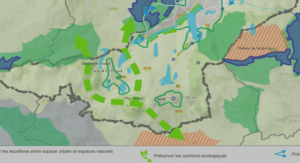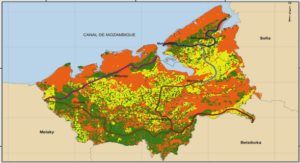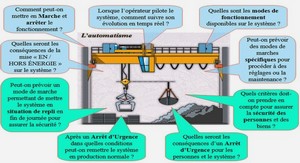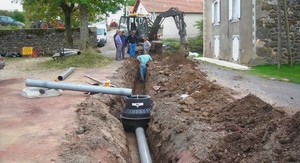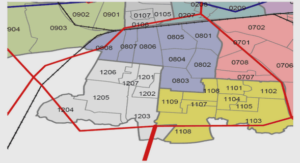UTILISATION DU 10BE COSMOGENIQUE PRODUIT IN-SITU POUR L’ETUDE DE LA DYNAMIQUE DES LATERITES
Introduction
Laterites cover about one-third of the continents. These widespread surficial formations result from meteoric weathering of igneous, metamorphic or sedimentary rocks (Nahon, 1986; Tardy, 1993). They consist of both residual and supergene minerals distributed vertically from the parent rock to the surface within three main layers, i.e. the saprolite (isovolumetric weathering), the nodular layer (non isovolumetric weathering with various degree of Fe enrichment) and the sandyclayey layer (bioturbated soil). The textural and the mineralogical development as well as the transformation of each weathering layer depend upon chemical and physical conditions which may have varied over time with climate changes. In Africa for example, where lateritic cover has developed from Tertiary to present time at the expenses of stable cratonic areas, two main types of present day observable lateritic sequences could be distinguished : 69 – laterites with simple isovolumetric alteration histories (low degree of textural polygenism) – laterites with complex histories of formation linked to variation in environmental conditions (high degree of polygenism). The low textural polygenism ones mainly consist of saprolitic layer overlaid by a thin bioturbated top soil. Such laterites have either recently developed by in situ chemical weathering or result from the mechanical surficial truncation of old high textural polygenism laterites. The high textural polygenism type exhibits all three main layers described above. The nodular layer, a mixture of residual quartz pebbles with goethitic and/or hematitic centimetric nodules, is more or less thick and massive (Lecomte, 1988). It results from a complex long term parent rock weathering history due to chemical digestion or erosive cycle changes under different types of tropical climates. Such laterites include the so called « stone-line » formations, very rich in quartz pebbles, whose origin is at present time under scientific controversy. While autochtonists propose an in situ genesis of their studied « stone-line » formations in West Africa (Collinet, 1969; Muller et al., 1981), allochthonists (Heinzelin, 1952; Riquier, 1969; Segalen, 1969) explain the presence of quartz pebbles over the saprolite by mechanical processes transporting materials resulting from large scale erosive cycles. Others have demonstrated that the « stone-lines » of Gabon (equatorial Africa) may be issued from both in situ chemical processes and para-autochthonous mechanical transport of materials at the scale of the topographical unit (Colin, 1992). In order to assess quantitatively the mechanisms involved in the development of African laterites, depth profiles of 10Be (T½= 1.5.106 yr.) produced in mineral lattices of rocks exposed to cosmic rays in the upper few meters of the Earth’s crust have been used. Because the flux of the cosmic rays decreases exponentially with subsurface depth, depth profiles of in situ-produced 10Be permit the study of surficial processes, the quantification of denudation and burial rates and the elucidation of mechanisms involved in landform evolution and soil formation (Brown et al., 1994; Cerling and Craig, 1994; Lal, 1987). This method may thus be employed to determine whether allochthonous or autochthonous processes dominate soil formation (Brown et al., 1994).
Sampling and methodology
Sites description
We collected samples at two sites: a recent road-cut through a small hill at the village of Malemba in the south-western Congo (4°20’S, 12°25’E; 300 m altitude), and a gold prospecting trench cut into a lateritic surface at Larafella, Burkina Faso (11°32’N, 2°47’W; 250 m altitude). 70 The Malemba hill has the rounded shape typically formed under warm humid conditions in tectonically stable regions. Near the hill’s summit, subvertical quartz veins penetrating the bedrock and saprolite have been exposed by the road cut. Relicts of these veins (20 to 30 cm quartz blocks) appear to continue through the soil almost to the surface. In addition, a « stone-line » of quartz cobbles extends downslope from the quartz vein, essentially following the interface between soil and saprolite. The upper 20 cm of the weathering profile consists of a gray-black humic layer. It is underlain by a 150 to 200 cm layer of yellow – brown microaggregated sandy-clayey soil and a thick saprolitic layer derived from in situ isostructural weathering of Proterozoic schist. The lower two layers are rich in quartz and kaolinite. In addition to collecting samples of the vein quartz, we sampled round and angular quartz cobbles incorporated downslope in the « stone-line » along the saprolite-soil interface (Figure 23). Determination of the 10Be content of these rocks permits us to examine the relative contributions of allochthonous and autochthonous processes to formation of « stone-lines » and rounded hills, typical of much of Equatorial West Africa. Figure 23: Sketch map showing the sample distribution at Malemba. A detailed understanding of the variability of cosmogenic nuclide production with subsurface depth is necessary for quantitative interpretation of the distributions of 10Be content of rocks sampled along soil profiles. Toward this end, we collected a depth profile of vein quartz passing through undisturbed saprolite in the lowland lateritic system at Larafella. This site is part of a complex system of lateritic surfaces (Bamba, 1993) that will be part of a forthcoming study of examination of tropical soils using cosmogenic nuclides. Although Larafella is climatically quite different from Malemba, the tectonic settings (and hence overall erosion rates), altitudes and geomagnetic latitudes are comparable. This means that depth variability of cosmogenic nuclide 71 production will be very similar at the two sites. Differences in the 10Be concentration depth profiles can be ascribed to differing weathering histories at the two sites.
Methods
Crushed and sieved (250-1000 µm) quartz samples were cleaned and prepared for 10Be analysis. To eliminate potential contamination by atmospherically produced 10Be, initial cleaning in concentrated HCl was followed by a series of four sequential hydrofluoric acid dissolution steps. This cleaned purified quartz was then completely dissolved in HF. Each sample was spiked with 0.3 mg of 9 Be carrier (Brown et al., 1991). After separation of Be by solvent extractions, BeO was purified by successive extractions and precipitations (Bourlès, 1988; Brown et al., 1992). All measurements were made by accelerator mass spectrometry at the Tandétron AMS Facility, Gifsur-Yvette, France (Raisbeck et al., 1994; Raisbeck et al., 1987). Analytical uncertainties (reported throughout as 1σ) are based on counting statistics and conservative assumptions of 5% variability in machine response and a 50% uncertainty in the blank correction. In general, the concentration N (at.g-1) of a radioactive cosmogenic nuclide produced by spallation reactions in a rock exposed at depth x (g.cm-2) below a surface undergoing erosion at a rate of ε (g.cm-2 yr -1) over time t (yr) may be represented by the equation: (Eq. 1) which states that in case of deep profile studied, the normal steady state erosion equation has to written as a sum of two terms, corresponding to the production of 10Be (P in at.g-1 .yr -1) cosmic ray neutrons and muons with their corresponding attenuation lengths, Λn and Λµ (g.cm-2) and their respective contribution pn and pµ to the total production (pn+pµ=1). In this study, all calculations use total surface 10Be production rates based on the altitude and latitude dependent polynomials of Lal (Lal, 1991), and error calculations assume a 15% uncertainty in production rates (Gosse et al., 1996a; Gosse et al., 1996b).
Results
Depth variability calibration at Larafella
The data from Larafella (Figure 24,Table 4) demonstrate the depth variability of 10Be production at a site that field observations indicate to be minimally perturbed by weathering and soil compaction. As shown in Figure 24, assuming neutron and muon attenuation lengths to be, respectively, on the order of 140 and 1300 g.cm-2 (Brown et al., 1995a), a 10Be production rate of 4.3 at.g-1 and allowing the erosion rate and the percentage of production due to muons to be 72 adjustable, the best data fit to (Eq. 1) yields a muon contribution to the total production at the surface of (1.5±0.2)% and an erosion rate of (2±0.3) m.My-1 (Brown et al., 1995a). Our results are consistent with previous works concluding that ~1-3% of surface production of 10Be was associated with reactions induced by muons (Brown et al., 1995a). This component needs to be considered for estimating levels of inherited cosmogenic nuclides when dating young surfaces.
Evolution of Malemba stone hill
Weathering resistant minerals
Because zircons and quartz are among the more weathering resistant phases under standard tropical weathering conditions, the related Zr and Si contents are used as weathering intensity indexes. Chemical analysis performed along the studied quartz vein shows that while the Si and Zr concentrations remain roughly constant along the quartz vein located in the parent rock, they continuously increase for both elements in the sandy-clayey layer (Table 2). More precisely, both Zr and Si concentrations continuously increase from the saprolite-sandy clayey layer interface to the surface. This is consistent with increased weathering intensity in the upper part of weathering profiles and typical of tropical soils where Zr contents have been used as immobile reference to estimate mass loss accompanying the weathering of the lithosphere as well as to calculate volumetric changes of soils with regards to the parent rock.
INTRODUCTION |

